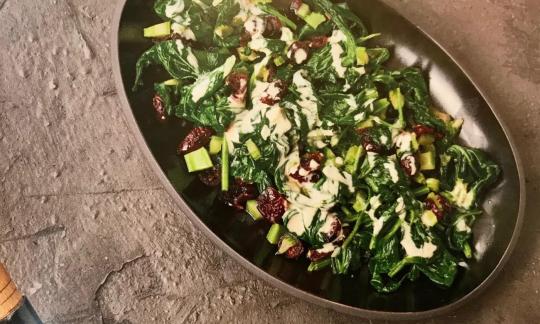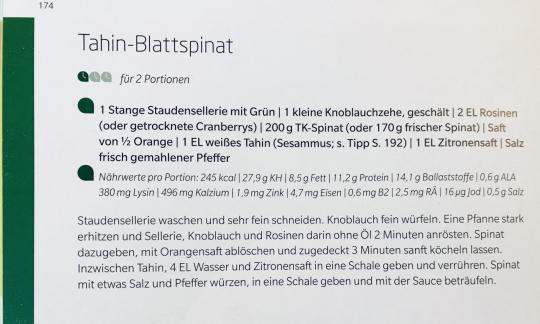Tahini leaf spinach with celery, raisins and orange juice
vegan
Ingredients (for servings, )
| 1 stalk | Celery (bleached celery), raw (organic?) (1.1 oz) |
| 1 clove | Garlic (organic?) (0.11 oz) |
| 2 tbsp | Raisins, raw? (organic?) (0.63 oz) |
| 5 ¾ oz | Spinach, raw (vegetable spinach) |
| 3 tbsp | Orange juice (raw?, organic?) (0.78 oz) |
| 1 tbsp | Tahini (sesame butter, raw?, organic?) (0.53 oz) |
| 4 tbsp | Drinking water, raw (organic?) (0.81 oz) |
| 1 tbsp | Lemon juice (raw?, organic?) (0.26 oz) |
| 1 dash | Table salt (table salt, raw?, organic?) (0.01 oz) |
| 1 dash | Black pepper (organic?, raw?) (0.00 oz) |
| topping | |
|---|---|
| ⅔ oz | Walnuts (tree nuts), raw (organic?) |
Equipment
- skillet (frying pan)
- stove
- citrus juicer (lemon squeezer)
- sieve
Type of preparation
- cook
- chop or grind
- squeeze
- dry roast
- deglaze
- remove the skin
- drain
Preparation
For the spinach
Wash the celery and chop very finely (including the green part). Peel the garlic and dice finely.The author recommended one small clove of garlic for 2 servings.
Heat a pan and fry the celery, garlic and raisins in it without oil for 2 minutes. Wash the spinach, drain and add. Deglaze with the freshly squeezed orange juice and simmer gently covered for 3 minutes.
The amount of orange juice for 2 servings corresponds to about ½ orange.
For 2 portions, you can use 200 g of frozen spinach or fresh chard instead of 170 g of fresh spinach.
As an alternative to raisins, you can use the same amount of dried cranberries.For the sauce
Meanwhile, put the tahini (white tahini) with the water and the freshly squeezed lemon juice in a bowl and mix.Completing the dish
Season the spinach with a little salt and pepper, put it in a bowl and drizzle with the sauce.
Roughly chop the walnuts and add them to the spinach.The original recipe does not contain walnuts. Please read the notes in the nutrient profile under "Recipe Notes".
|
Nutritional Information per person
Convert per 100g
|
2000 kcal | |
|---|---|---|
| Energy | 167 kcal | 8.3% |
| Fat/Lipids | 11 g | 15.6% |
| Saturated Fats | 1.2 g | 6.2% |
| Carbohydrates (inc.dietary fiber) | 16 g | 5.8% |
| Sugars | 7.2 g | 8.0% |
| Fiber | 3.5 g | 14.2% |
| Protein/Albumin | 5.8 g | 11.7% |
| Cooking Salt (Na:161.4 mg) | 410 mg | 17.1% |
| Essential micronutrients with the highest proportions | per person | 2000 kcal | |
|---|---|---|---|
| Vit | Vitamin K | 416 µg | 554.0% |
| Vit | Folate, as the active form of folic acid (née vitamin B9 and | 192 µg | 96.0% |
| Min | Manganese, Mn | 1.2 mg | 59.0% |
| Fat | Linoleic acid; LA; 18:2 omega-6 | 5.4 g | 54.0% |
| Fat | Alpha-Linolenic acid; ALA; 18:3 omega-3 | 1.1 g | 53.0% |
| Vit | Vitamin A, as RAE | 403 µg | 50.0% |
| Min | Copper, Cu | 0.44 mg | 44.0% |
| Vit | Vitamin C (ascorbic acid) | 32 mg | 41.0% |
| Elem | Potassium, K | 692 mg | 35.0% |
| Elem | Magnesium, Mg | 97 mg | 26.0% |
Detailed Nutritional Information per Person for this Recipe
The majority of the nutritional information comes from the USDA (US Department of Agriculture). This means that the information for natural products is often incomplete or only given within broader categories, whereas in most cases products made from these have more complete information displayed.
If we take flaxseed, for example, the important essential amino acid ALA (omega-3) is only included in an overarching category whereas for flaxseed oil ALA is listed specifically. In time, we will be able to change this, but it will require a lot of work. An “i” appears behind ingredients that have been adjusted and an explanation appears when you hover over this symbol.
For Erb Muesli, the original calculations resulted in 48 % of the daily requirement of ALA — but with the correction, we see that the muesli actually covers >100 % of the necessary recommendation for the omega-3 fatty acid ALA. Our goal is to eventually be able to compare the nutritional value of our recipes with those that are used in conventional western lifestyles.
| Essential fatty acids | per person | 2000 kcal |
|---|---|---|
| Linoleic acid; LA; 18:2 omega-6 | 5.4 g | 54.0% |
| Alpha-Linolenic acid; ALA; 18:3 omega-3 | 1.1 g | 53.0% |
| Essential amino acids | per person | 2000 kcal |
|---|---|---|
| Tryptophan (Trp, W) | 0.06 g | 23.0% |
| Threonine (Thr, T) | 0.18 g | 19.0% |
| Isoleucine (Ile, I) | 0.20 g | 16.0% |
| Leucine (Leu, L) | 0.33 g | 14.0% |
| Valine (Val, V) | 0.23 g | 14.0% |
| Phenylalanine (Phe, F) | 0.19 g | 13.0% |
| Lysine (Lys, K) | 0.21 g | 11.0% |
| Methionine (Met, M) | 0.07 g | 8.0% |
| Vitamins | per person | 2000 kcal |
|---|---|---|
| Vitamin K | 416 µg | 554.0% |
| Folate, as the active form of folic acid (née vitamin B9 and | 192 µg | 96.0% |
| Vitamin A, as RAE | 403 µg | 50.0% |
| Vitamin C (ascorbic acid) | 32 mg | 41.0% |
| Thiamine (vitamin B1) | 0.25 mg | 22.0% |
| Vitamin B6 (pyridoxine) | 0.28 mg | 20.0% |
| Biotin (ex vitamin B7, H) | 9.5 µg | 19.0% |
| Riboflavin (vitamin B2) | 0.21 mg | 15.0% |
| Vitamin E, as a-TEs | 1.9 mg | 15.0% |
| Niacin (née vitamin B3) | 1.3 mg | 8.0% |
| Pantothenic acid (vitamin B5) | 0.19 mg | 3.0% |
| Essential macroelements (macronutrients) | per person | 2000 kcal |
|---|---|---|
| Potassium, K | 692 mg | 35.0% |
| Magnesium, Mg | 97 mg | 26.0% |
| Phosphorus, P | 153 mg | 22.0% |
| Sodium, Na | 161 mg | 20.0% |
| Calcium, Ca | 120 mg | 15.0% |
| Essential trace elements (micronutrients) | per person | 2000 kcal |
|---|---|---|
| Manganese, Mn | 1.2 mg | 59.0% |
| Copper, Cu | 0.44 mg | 44.0% |
| Iron, Fe | 3.2 mg | 23.0% |
| Zinc, Zn | 1.2 mg | 12.0% |
| Selenium, Se | 4.3 µg | 8.0% |
| Iod, I (Jod, J) | 10 µg | 7.0% |
| Fluorine, F | 31 µg | 1.0% |
The tahini leaf spinach with celery, raisins, walnuts and orange juice is an oriental side dish.
Nutrient profile: According to GDA guidelines, one portion of this recipe covers more than 5 times the average daily requirement of vitamin K. Folic acid, vitamin A, manganese and omega-3 fatty acids are covered by over 50%. By adding walnuts, we were able to reduce the ratio of omega-6 to omega-3 fatty acids from 11:1 to 5:1, so that it no longer exceeds the maximum recommended ratio of 5:1. Read more at: Vegans often eat unhealthily. Avoidable nutritional errors.
Heating during cooking results in a slight loss of nutrients. Since the nutrient profile refers to the uncooked ingredients, the values are actually slightly lower.
Celery: Celery, also known as celery root, is one of the vegetables with the fewest calories. In addition to its high water content, it also contains a variety of vitamins and minerals. It has a slightly diuretic effect. Caution: People who are allergic to birch pollen and mugwort may experience a cross allergy when eating celery.
Spinach: Spinach is rich in vitamins (especially vitamin K, folic acid, vitamin A and vitamin C), protein and minerals. Although spinach has a high iron content among vegetables, the iron content is not exceptionally high. Despite the high oxalic acid content, consuming raw spinach in reasonable amounts is not harmful to health.
Tahini: The nutty-tasting sesame butter known as tahini is made from sesame seeds processed into a kind of paste. It is also available in raw form, where the sesame seeds are placed in water without being roasted, and in the commercially available roasted form.
Tahini: Tahini can be found in Germany in every Turkish specialty shop and well-stocked supermarket. Tahini made from peeled sesame seeds can be recognized by the fact that it is very light and almost liquid. It should not taste bitter.





